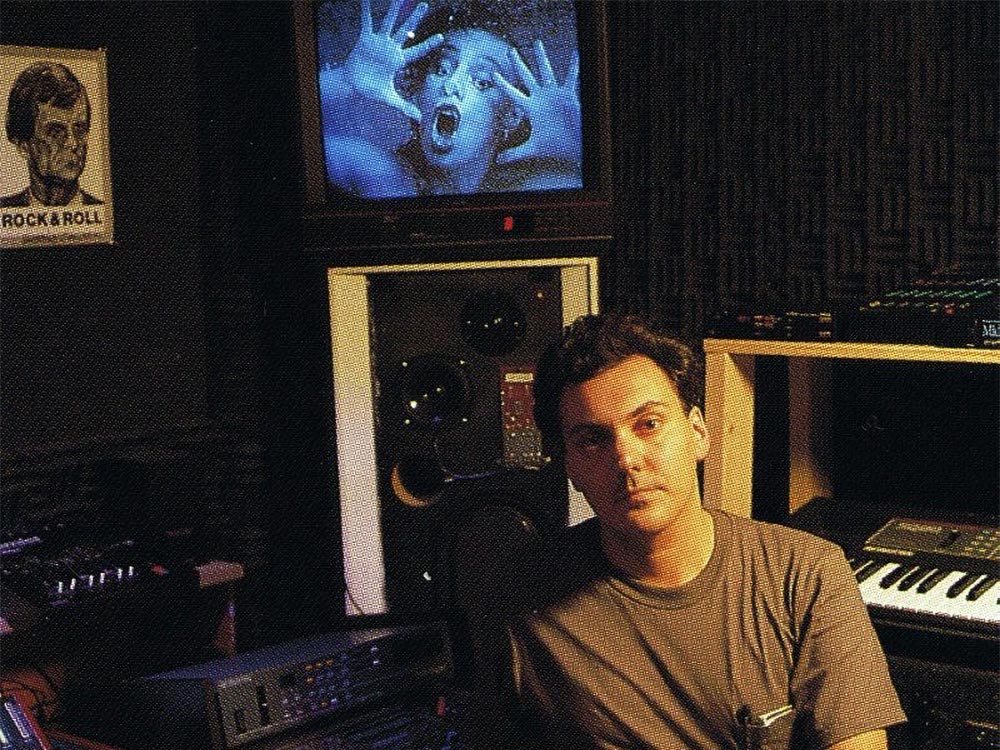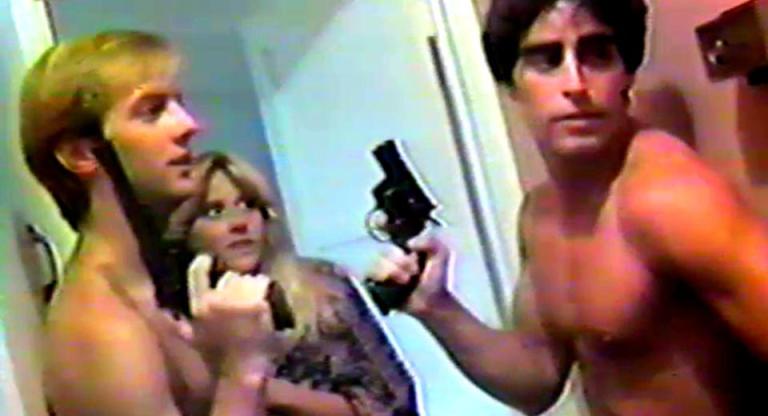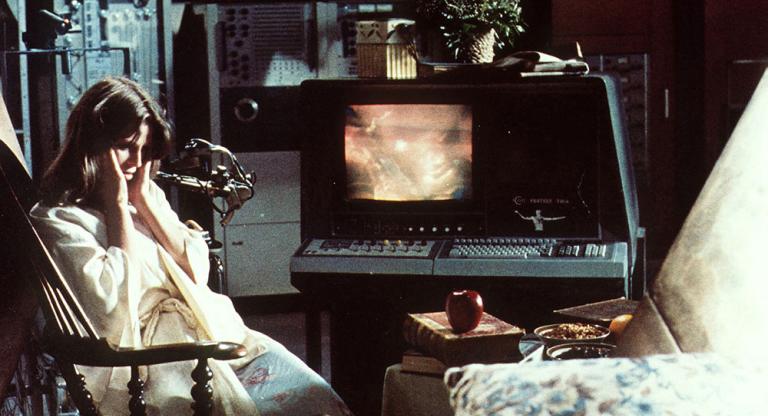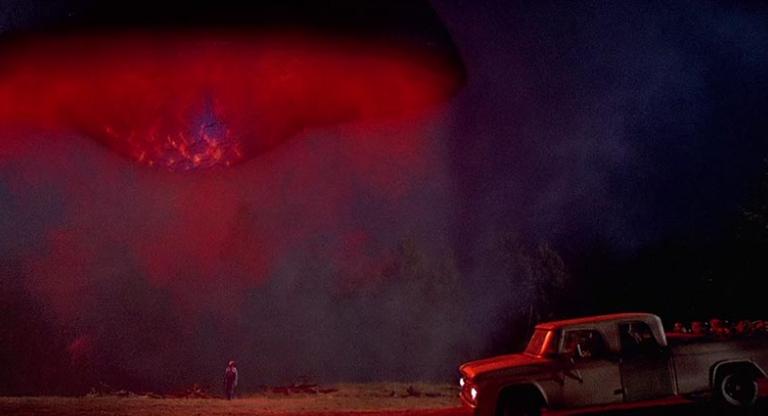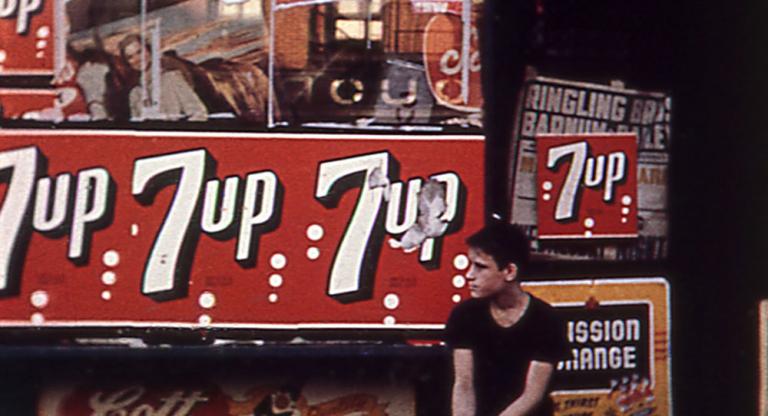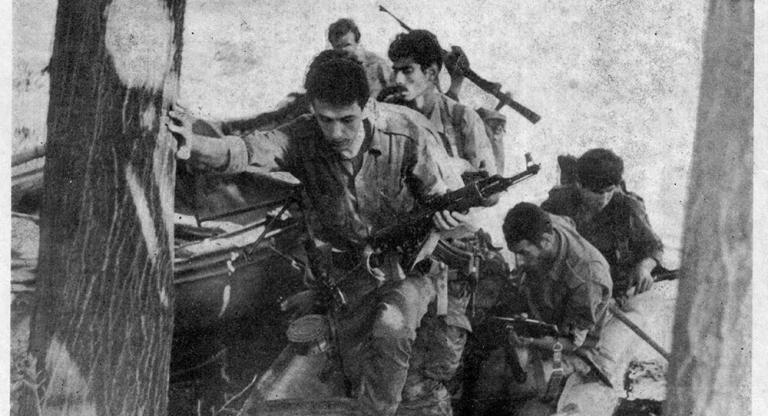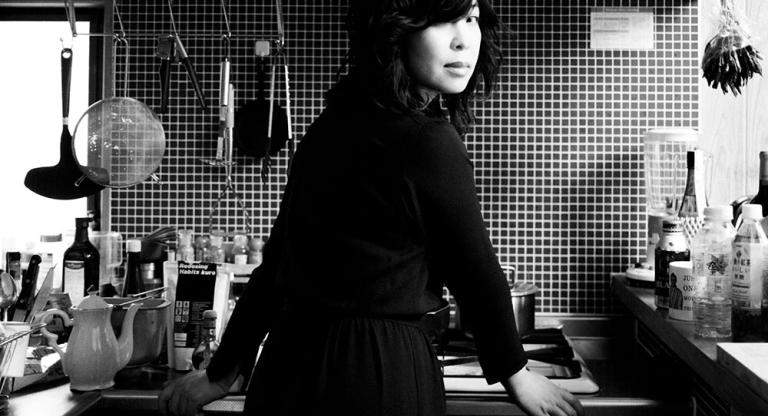The media center EZTV is a winsome outlier in the history of Los Angeles alternative arts. Founded in 1979 by video artist John Dorr, a former D. W. Griffith scholar who produced a series of shoestring psychodramas on Betamax, by the mid-’80s the West Hollywood organization had bloomed into an open-access media laboratory, independent production company, 40-seat theater, and gallery space. The center’s anything-goes spirit brought together a peculiar cross-section of the city’s cultural landscape, commingling abstract experiments in motion-capture video, feminist performance and dance, transgressive exhibitions by R. Crumb and Sheree Rose & Bob Flanagan, and SOV cheapies like James Robert Baker’s Blonde Death (1984).
Under the moniker of Vertical Blanking, artists and key EZTV members Michael J. Masucci and ia Kamandalu (née Kim McKillip) collaborated on a string of projects between 1986 and 1993. Shot and edited on a homebrewed mix of analog and desktop hardware, the duo’s productions ranged from ultra-low-budget music videos to intricate, Sony-sponsored multimedia collaborations with dance companies. They often drew on the pair’s mutual interest in esoteric philosophy and the UFO phenomenon, adapting abduction testimonies in videos like Deposition (1991) and NightLight (1992). These raw and strobic videos are rife with many of the high-water marks of ’90s proto-digital aesthetics: propulsive editing and computer-generated visuals, “fourth world” trance music, and hints of a cyber-inflected New Age spirituality.
On the occasion of Vertical Blanking’s inclusion in Watch the Skies, Screen Slate’s survey of ufology on screen, I chatted with Masucci, who continues to direct EZTV. In recent years, the organization’s history has been saluted through retrospective screenings at the Centre Pompidou, a major archival acquisition by the University of Southern California, and a still-mounting grassroots revival of Blonde Death, gradually revealing a colorful, secret history of unruly West Coast video that continues to unfurl.
Tyler Maxin: How did Vertical Blanking get its start?
Michael J. Masucci: There's no way to separate it from EZTV's history; they are completely intertwined. ia Kamandalu, who was called Kim McKillip when I first met her, had been part of EZTV since 1986. I was a founding member, although the original founder, John Dorr, began the notion in 1979 when he began producing what would become four feature-length projects on home analog Betamax. It’s probably important to give context on where EZTV began and its political angle. In many ways, without being on-the-nose overtly political, EZTV was very much part of the queer revolution.
I'm a cisgender, straight man, but the overwhelming majority of founding members of EZTV were queer men in West Hollywood. At the time, neither Hollywood nor the contemporary art world—and I know there's a lot of revisionist history that says, "Oh no, we were always inclusive . . . " Baloney! The reality is that an openly gay man was not really welcome in Hollywood, and [they] were only slightly more welcome in the art world. In both places [non-normative sexual orientations] were— if not career killers, [they] definitely dampened the ability to have a successful career. So John Dorr, the founder, and a number of his buddies got together and said, "Well, we're gonna create our own world. We're gonna create our own scene,” and started doing public screenings of their own work. Then, in 1982, [they] scrounged together a small amount of money and rented a tiny little space in West Hollywood, and that was EZTV.
I was at that point doing what would now be called raves: very abstract, live, psychedelic projection light shows. A large number of the nightclubs in Los Angeles—to this day, but at that time [as well]—were in West Hollywood because West Hollywood wasn't really incorporated as a city, so the laws were much more ambiguous. You were able to get away with a lot more there. I navigated to EZTV rather than the obvious choice, which would've been the Long Beach Museum Video Annex, [which was] very storied, video art, artsy fartsy.
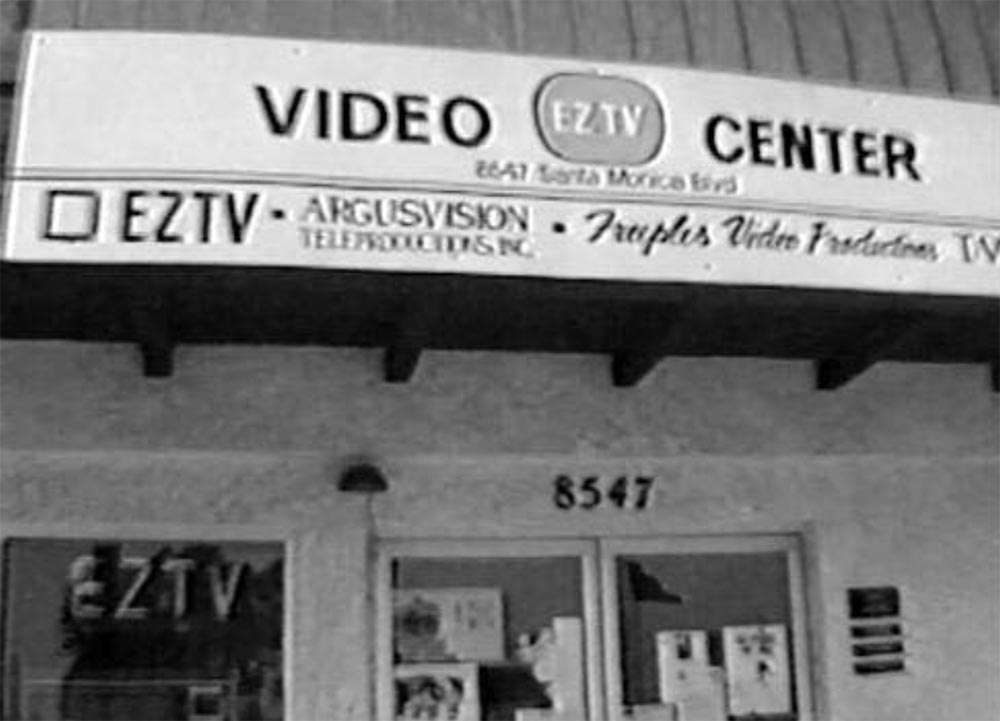
TM: Going back to your initial experience doing live music projection in West Hollywood, what was that music scene like?
MJM: So the night clubs—and they almost all still do it this way—would have theme nights. They would cater to different communities on different nights. So there would be a rock night, there would be a hardcore-punk night, and there would be disco night, and there would be nights that were really focused on the burgeoning West Hollywood queer community. Those tended to be the most exciting because you had the largest diversity coming out for that. Most of the other communities were still quite segregated. The rock scene was pretty white, the punk scene was entirely white. The queer scene was diverse: there were Latinxs, there were African Americans, there were Asians. In a strange way, even though I was a straight guy, I felt more at home in the nights where go-go boys in gold spandex shorts were dancing in the cages instead of beautiful young women in bikinis, which is what would happen in the other nights.
There were five or six clubs, the largest of which—long defunct—was a place called Osca's. It was quite large and it had a really good (for its time) projector and an amazing sound system, and they let me experiment. To be honest, they didn't really care what was being projected, that is the truth, as long as it was colorful and crazy and wild. And so I got to do more and more experimental stuff and started hot-rodding very, very early, crude computing devices with some pretty conventional analog-video equipment, so I could do all kinds of layering and stuff that would now be called VJ-ing, at a time when there was really only one other person in LA I knew about who was doing that: a guy named Ron Hays. Ron is another person who was lost to the AIDS pandemic. In a strange way, we were very friendly competitors. We respected each other a great deal. He was much higher up the food chain; he had worked with Madonna and with symphony orchestras—big stuff.
TM: He was active in the New York video scene in the early ’70s. He had a company on the East Coast called Music Image Workshop and did visuals for Hollywood productions like Grease (1978) and Demon Seed (1977).
MJM: That's absolutely right. In LA he ran a company called Megavision, not to be confused with another company of the same name that started after he passed away. Ron had access to some fancy toys, but he still enjoyed playing in this same playground that I played in. As he got sick, he handed some of the people that he thought I would like to play with over, and they ended up being, in one case, a collaborator I worked with for 20 years. He did some really wild stuff. He was floating balloons up in the sky and projecting onto them.
But other than Ron, there really wasn't anybody doing stuff like that in LA. I'm sure there were all over the world, but not so much there. Most of what you would see in clubs were old Fred Astaire movies being projected and Plan 9 from Outer Space [1959]. But this was experimental. I was a bit pretentious, I took it seriously, I thought this was art. The logical thing would've been for me to bang on the doors of the Long Beach Museum, and I certainly did and knew those people, but it didn't feel like home. Whereas this much more free-form, kind of anarchistic, kind of inappropriate culture was much more to my liking. And I appreciated being challenged and shocked and offended, and I tried my best to do the same to other people.
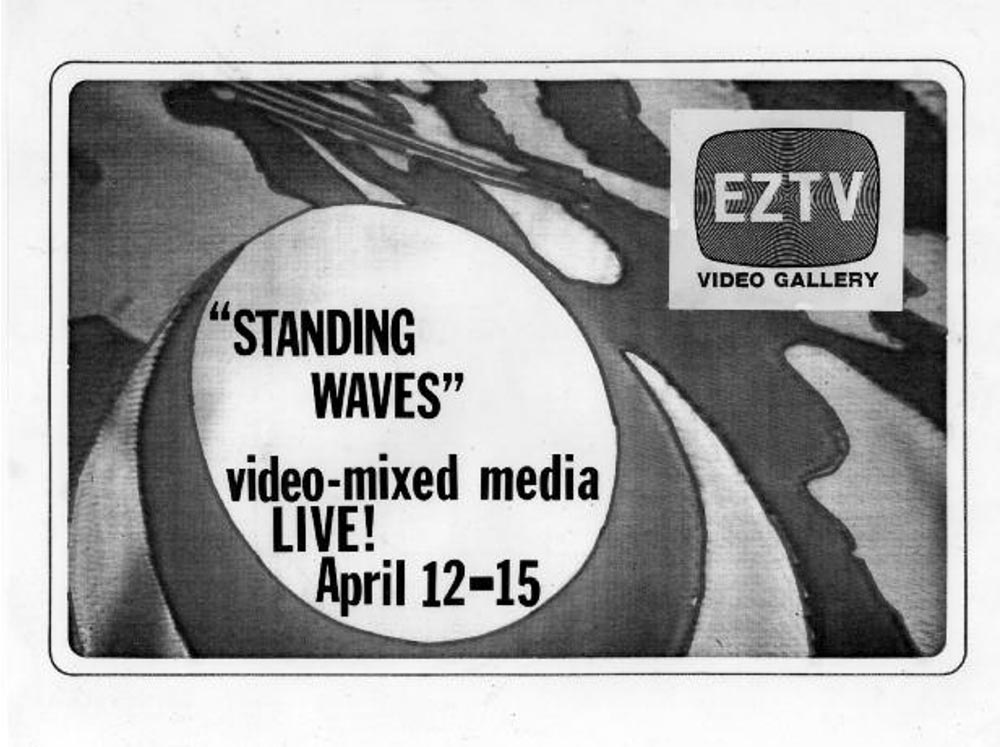
TM: How did you meet ia Kamandalu and begin collaborating?
MJM: EZTV became home, and to this day [it still] is. I got kicked upstairs rather quickly. By 1986, I was the co-artistic director and gallery curator. We were doing a screening, and Kim McKillip attended it. We started talking, and then we started collaborating. We collaborated on a number of pieces for about seven years. We were both musicians and performers and video artists, so we wanted to do something that was more along the lines of a music group, but as video artists. We had done a previous piece called Lemuria [1986], which is a pretty interesting abstract piece. That got a little bit of noise locally, and we sold some VHS tapes and all of that.
Then she walks in one day with a poem [with] a staunchly feminist perspective about male stereotypes against women. I suggested we turn it into a video-poem, and that began a series of pieces, [among them] Deposition [1991]. We both had interests in ufology and were like amateur researchers. A lot of Vertical Blanking's work was UFO themed, but not all of it. We did those canned videos like Deposition, but also did a number of multimedia experiences, where the music was either live or more often than not a combination of playing [recorded] tracks and live performances, alongside large-scale projection.
Like many of the EZTV-ers, John Dorr, the founder, had AIDS. As he got sicker and sicker, it was pretty clear that Vertical Blanking was going to have to make a decision. At the time of John's death, which was New Year's Day, 1993, Vertical Blanking was on a roll. We had just done this very large-scale theater piece with a ballet company, a theater company, two giant projection systems, music—an amazing event at the end of something called a Cyber Arts International Conference. We were being sponsored by Sony. It looked like that's what we were going to do. And then John died.
A mentor of ours was the late, great Dr. Timothy Leary, [who] gave me my first good computer. We would do psychedelic light shows together, and Tim did a number of live performances at EZTV. Two days after John died, ia and I are at Tim's house, breaking into his best Irish whiskey. Tim, having been a trained professional psychologist, just laid it out and it was pretty clear. He said, "Look, let's face it. Let's just cut to the chase. You're not leaving EZTV, you're not gonna go to let EZTV die. Let's face it. That's what's gonna happen. So what you've gotta do is figure out how that's gonna work." The breakout of that was that it was almost impossible for ia and I to keep working.
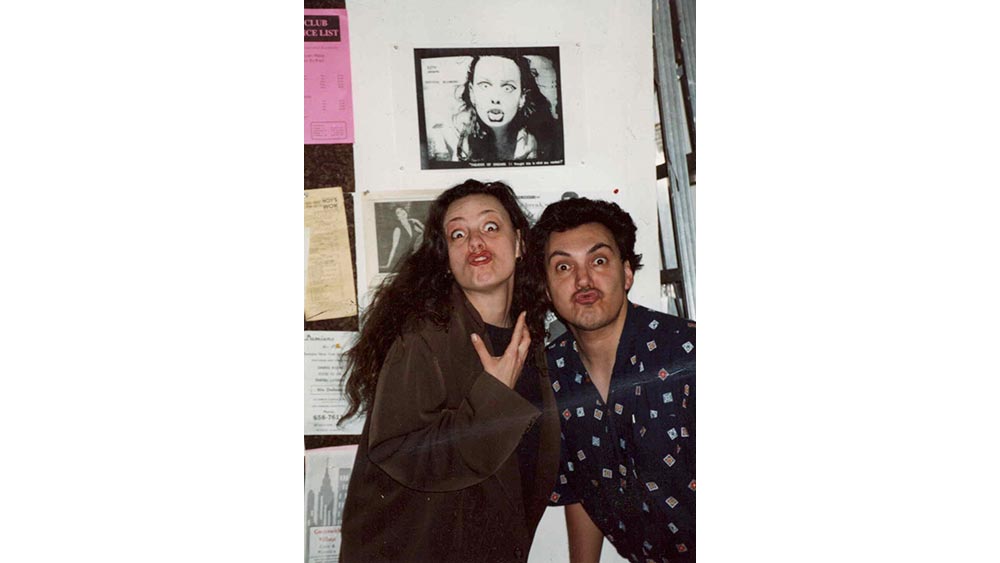
We tried, but more and more, I ended up having to take on the role of an administrator. And ia stayed on for a couple of years as an editor, and then migrated more towards trying to make it in the ambient-trance music scene. She developed a lot of spiritual philosophies that she was very dedicated to. And very slowly—[there was] never officially any breakup or schism—she would show up less and less, and the periods would go from peeking in once a month to peeking in once a year. Finally, it was over. But, EZTV was really—and still is, in a strange way—a meeting ground for a lot of the people that were being excluded from either the mainstreams of Hollywood or the art world.
So many of the leading feminist performance artists of the time, many of the punk-rock bands, virtually all of the computer artists of note— that may be what EZTV's largest legacy is, other than its queer archive, is its contribution to the LA digital art (what we originally called computer art) scene. Two years [from now] will be EZTV's 45th anniversary, and there's gonna be a massive six-month retrospective staged at one of the local colleges here, Santa Monica College. We'll see how far it goes, but it's gonna be screenings and panel discussions and lectures and large-scale site-specific reenactments of major projection pieces and performance pieces. So, while looking forward, making new work, we're spending a lot of time these days looking to the past and trying to see what is the essential catalog of EZTV's work.
A while ago, in 2014, we donated a good deal of the early archives to USC which has the largest queer archive on the planet. So a lot of that work is now going to be preserved, and there's already been some scholarly investigations into it. So that part is being covered. Now we're more concerned with making sure the same happens to the digital-art history. What's commonplace today in an arts scene was pretty rare in the 1980s, and still [rare in] the 1990s, where you could see live multimedia work combining video and sampling and live performance and projection. But that was ubiquitous there, along with feature-length work, work more akin to cinema. We really saw ourselves as a place that would allow what wasn't being shown in other places, and to some extent [we] still do, although there's no longer a need to be a community-access center, which was very much an early thing we felt we needed to do. That's no longer the case since people can shoot and edit on their phones now.
TM: Could you talk a bit about the context of the subject matter? Even starting with Lemuria, Vertical Blanking was touching on spiritual themes.
MJM: Yeah. I've been sort of hiding my New Age-ism because I think it gets too easily misinterpreted. Both ia and I were very interested, I would rather say, in philosophy. What the truth of this universe is, I don't know. I don't claim to know. I don't know where the universe came from. I don't know what happens after you die. But I'm very interested in all those questions. ia and I clearly believed that we had not been told the truth about things concerning UFOs, extraterrestrials, Roswell, blah blah blah—not claiming to know what is true. We know it wasn't a weather balloon that crashed in Roswell. We know there's too many pieces of the puzzle that point to [the idea] that the government has known a lot of stuff for a long time.
Long before the History Channel made this pop-culture mainstream, it was kind of difficult to discuss these things seriously. ia and I had trouble getting people to go on the record. And we weren't trying to do documentaries, so that was not a problem. We would talk to people—in the case of Deposition, a family in Detroit who had three generations of people claiming to have inexplicable experiences that are best described as alien abduction. Not wanting to out them, make fools of them, humiliate them, draw attention to them, we made abstract art pieces and got dancers and performance artists to act out their story.
But the story in Deposition is what was described to us. It was basically what somebody sat down and told us. It was easier for us to go around in our crazy little art world and show it as, "Oh, we are just crazy artists. We do crazy stuff," rather than pretend that we're claiming any veracity to this, having no evidence. I know the people telling me this stuff believe what they're saying. I know they're not lying. I know they're not making it up. Whether what they're telling is exactly what really happened and not clouded by fears, I can't say. But I know they're not lying. And I've looked in the eyes of way too many people who have told me pretty much the same story over and over and over again, that I know that this is something of immense sociological value.
And now, in the last few years, with the New York Times outing those Navy UAPs [unidentified aerial phenomena], disclosure has happened in a very light kind of way. So those videos are either the Chinese (they're not the Chinese), the Russians (they're not the Russians), or something else, right? So there have been people who have known this for 50 years, 70 years. ia and I sat and interviewed all of the stellar UFO experts at that period. Whitley [Strieber], [Bruce] Maccabee, John Lear, on and on and on.
We were given access to pretty much anyone we would ask through UFO Magazine. The curator Michelle Hirschhorn had hooked us up with the people there. When certain experts were in town, they would give us a heads up and they would ask if we wanted 40 minutes with them. Whenever we could, we said yes. We never attempted to try to show them as documentaries. The only exception was the curator Tyler Stallings' show Are We Touched (1997), many years ago. We set that up more as an installation including some of the interviews.
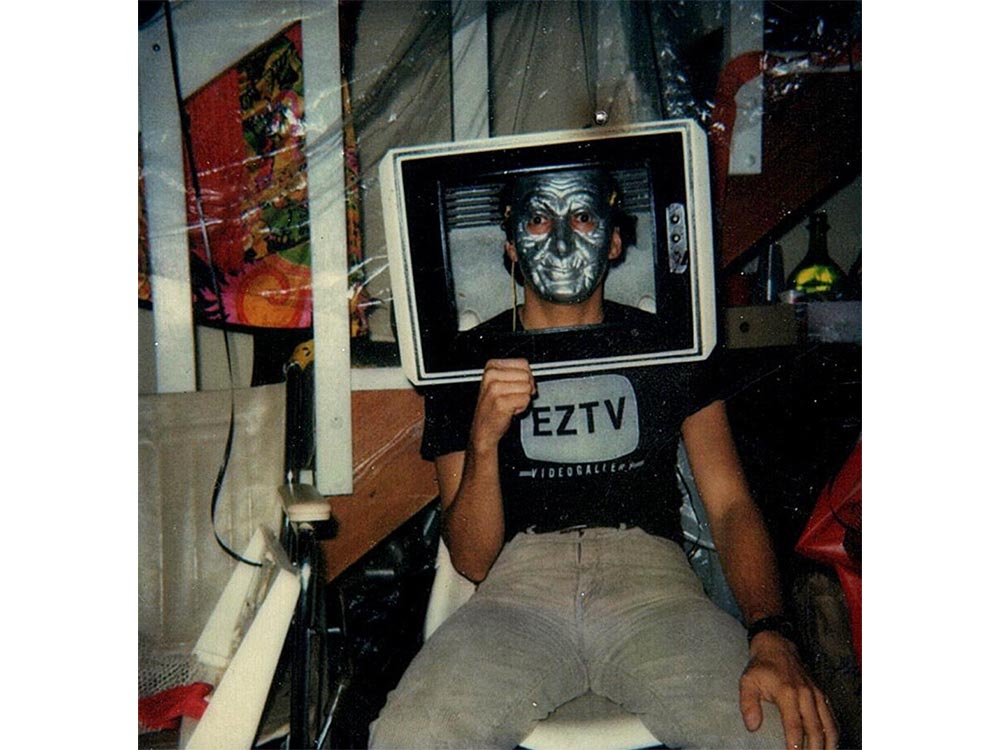
TM: Describe a bit about where you were showing these videos. You were making work in a peculiar time in the analog-to-digital changeover. As a result, your videos functioned almost like demonstrations. Could you talk about that context?
MJM: You couldn't be more right. Deposition premiered as a demonstration. So I mentioned the Cyber Arts International conferences, [for] the finale of which we did this giant multimedia live thing. Cyber Arts International conferences ran for three years, ’90 to ’92. For the second year, they asked me to do a lecture—they had some fancy word for it—and to make something that I would stand by for the very least amount of money. [There was] a pretty wide range of how much [money] it could be, but it had to be the least that I would be able to show in front of a large auditorium with a straight face. ia and I collaborated, and we did Deposition.
At the time, the subject matter wasn't something that was likely to be mainstream. Very shortly after that, The X-Files came out, but in ’91 there wasn't a lot of talk about alien abduction in the mainstream. And we made it for $384 in 1991 money. We worked with an environmental group that would reclaim things, so we got materials to make the crazy cabin, that shack that the little girl is in. That cost nothing. The costumes— we were able to strike a deal with a rental agency and got them for next to nothing. So we really tried to show what DIY could be without knowing that term yet. That term may have existed, but I hadn't heard of it yet.
It showed at a conference as an example of what you can do with next to nothing. It was shot on Video-8 and VHS, analog home equipment. A lot of these things were shown at conferences, universities, and then there was a whole small tour around the LA Basin. There were a lot of clubs—the Lhasa Club, the Anti-Club, all these defunct clubs that were at their time legendary—that would show this kind of stuff, in addition to EZTV, which had a hundred-seat theater. Actually, even that notion of doing this stuff as demos persisted for quite a while.
Are you familiar with SIGGRAPH? They’re like the American Medical Association for digital art, a special-interest group for “computer graphics and interactive techniques.” They've been around for 55 years, but for their 30th anniversary, they asked us—ia was gone at this point; we still knew her, but she had moved into the music thing—to do the opening gala piece with sort of the same mission: do something for the least amount that that she would find credible. With this one, we spent a whopping $2,000, and we made a feature, again with a heavy UFO theme. Again, more as a demo. At that point we were actually editing on laptops. So that was a big transition for us in 2003. We were not entirely digital, because we still preferred some of the analog cameras, but then we would digitize the video.
So that demo model—presenting work, premiering it at conferences—is actually still happening. It's going to happen next year. There's a conference on, of all things, telemedicine and cybersecurity that I'm gonna make an art piece and do a presentation at and demo. One of the strange things about video, and more like digital video now, is that as early adopters, we were in the zeitgeist of many other fields. So I'm not a computer hacker—I can code a little—but I've spoken at the leading computer hacker conferences in the world. I've spoken at the leading transhumanist conferences in the world.
I am not a transhumanist. I don't have any chips in my brain that I know about. And now I'm gonna be speaking at a telemedicine conference, not that I know anything about it. But I do know how the tools work, and I do have insights into perhaps a better use of the technology [that] could be adopted, which is why they've asked me to go and shoot my mouth off. So I will, again, make an art piece as a demonstration of a better way for medical doctors to use video, because the language of cinema has become the language. The written word is still the way we communicate, but more and more it's the “written word” as then shot with a camera and presented via media. So that's become what EZTV has evolved into, a kind of cultural ambassador between all of these weird subcultures: the hackers, the transhumanists, the art world, the feminist world, the cybersecurity world.
Deposition screens tonight, November 4, and next week, at Anthology Film Archives as part of the series “Watch the Skies: Ufology on Screen,” presented by Screen Slate. It will precede Fire in the Sky (1993).
